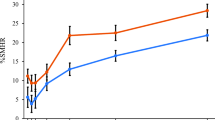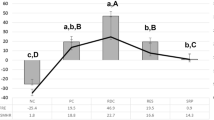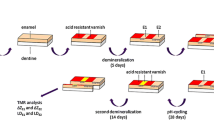Abstract
Objectives
The aim of this study was to investigate the effect of a dentifrice that contains calcium silicate, sodium phosphate, and fluoride on erosive-abrasive enamel wear.
Material and Methods
This randomized, single-blind in situ/ex vivo study was conducted with four crossover phases of 5 days (one group tested per phase). Bovine enamel blocks (n = 256) were allocated to 16 volunteers and 8 groups. The groups under study were test dentifrice, with calcium silicate, sodium phosphate, and 1450 ppm sodium monofluorophosphate; tin dentifrice, with 3500 ppm stannous chloride, 700 ppm amine fluoride, and 700 ppm sodium fluoride; conventional dentifrice, with 1450 ppm sodium monofluorophosphate; and control (deionized water). Half of the enamel blocks were subjected to erosion and the other half to erosion plus abrasion. The daily extraoral protocol consisted in four citric acid exposures (2 min) and two applications of dentifrice slurry on all blocks for 30 s; after, half of the blocks were brushed for 15 s. The response variable was enamel loss. Data were analyzed by two-way ANOVA and Fisher’s test (p < 0.05).
Results
For erosion, the test dentifrice promoted less enamel loss than water (4.7 ± 3.1 and 5.8 ± 2.5 μm, respectively, p < 0.05), and did not differ from tin (4.8 ± 2.5 μm) and conventional (4.8 ± 1.4 μm) dentifrices (p > 0.05). However, the test dentifrice (7.7 ± 3.8 μm) promoted higher wear after erosive plus abrasive procedures than tin (5.4 ± 1.5 μm) and conventional (6.2 ± 1.7 μm, p < 0.05) dentifrices, and did not differ from water (6.9 ± 2.0 μm).
Conclusions
The investigated dentifrice reduced enamel loss against acid challenge but had no effect against acid and brushing challenge.
Clinical Relevance
Little is known regarding the preventive effect of dentifrices indicated for dental erosion. The tested anti-erosive dentifrice was unable to protect enamel when erosion was associated to toothbrushing abrasion.
Similar content being viewed by others
References
Carvalho TS, Colon P, Ganss C, Huysmans MC, Lussi A, Schlueter N, Schmalz G, Shellis RP, Tveit AB, Wiegand A (2015) Consensus report of the European Federation of Conservative Dentistry: erosive tooth wear—diagnosis and management. Clin Oral Investig 19:1557–1561. https://doi.org/10.1007/s00784-015-1511-7
Shellis RP, Addy M (2014) The interactions between attrition, abrasion and erosion in tooth wear. Monogr Oral Sci 25:32–45. https://doi.org/10.1159/000359936
Jaeggi T, Lussi A (2014) Prevalence, incidence and distribution of erosion. Monogr Oral Sci 25:55–73. https://doi.org/10.1159/000360973
Salas MM, Nascimento GG, Huysmans MC, Demarco FF (2015) Estimated prevalence of erosive tooth wear in permanent teeth of children and adolescents: an epidemiological systematic review and meta-regression analysis. J Dent 43:42–50. https://doi.org/10.1016/j.jdent.2014.10.012
Carvalho TS, Lussi A, Jaeggi T, Gambon DL (2014) Erosive tooth wear in children. Monogr Oral Sci 25:262–278. https://doi.org/10.1159/000360712
Lussi A, Carvalho TS (2014) Erosive tooth wear: a multifatorial condition of growing concern and increasing knowledge. Monogr Oral Sci 25:1–15. https://doi.org/10.1159/000360380
Hornby K, Ricketts SR, Philpotts CJ, Joiner A, Schemehorn B, Willson R (2014) Enhanced enamel benefits from a novel toothpaste and dual phase gel containing calcium silicate and sodium phosphate salts. J Dent 42:S39–S45. https://doi.org/10.1016/S0300-5712(14)50006-1
Joiner A, Schäfer F, Naeeni MM, Gupta AK, Zero DT (2014) Remineralisation effect of a dual-phase calcium silicate/phosphate gel combined with calcium silicate/phosphate toothpaste on acid-challenged enamel in situ. J Dent 42:S53–S59. https://doi.org/10.1016/S0300-5712(14)50008-5
Jones SB, Davies M, Chapman N, Willson R, Hornby K, Joiner A, West NX (2014) Introduction of an interproximal mineralisation model to measure remineralisation caused by novel formulations containing calcium silicate, sodium phosphate salts and fluoride. J Dent 42:S46–S52. https://doi.org/10.1016/S0300-5712(14)50007-3
Faller RV, Eversole SL, Saunders-Burkhardt K (2014) Protective benefits of a stabilised stannous-containing fluoride dentifrice against erosive acid damage. Int Dent J 64:29–34. https://doi.org/10.1111/idj.12100
Faller RV, Eversole SL, Tzeghai GE (2011) Enamel protection: a comparison of marketed dentifrice performance against dental erosion. Am J Dent 24:205–210
Magalhães AC, Wiegand A, Buzalaf MA (2014) Use of dentifrices to prevent erosive tooth wear: harmful or helpful? Braz Oral Res 28:1–6. https://doi.org/10.1590/S1806-83242013005000035
Ganss C, Lussi A, Grunau O, Klimek J, Schlueter N (2011) Conventional and anti-erosion fluoride toothpastes: effect on enamel erosion and erosion-abrasion. Caries Res 45:581–589. https://doi.org/10.1159/000334318
Wiegand A, Schneider S, Sener B, Roos M, Attin T (2014) Stability against brushing abrasion and the erosion-protective effect of different fluoride compounds. Caries Res 48:154–162. https://doi.org/10.1159/000353143
Jaeggi T, Lussi A (1999) Toothbrush abrasion of erosively altered enamel after intraoral exposure to saliva: an in situ study. Caries Res 33:455–461. https://doi.org/10.1159/000016551
Li X, Wang J, Joiner A, Chang J (2014) The remineralisation of enamel: a review of the literature. J Dent 42:S12–S20. https://doi.org/10.1016/S0300-5712(14)50003-6
Hannigan A, Lynch CD (2013) Statistical methodology in oral and dental research: pitfalls and recommendations. J Dent 41:385–392. https://doi.org/10.1016/j.jdent.2013.02.013
Wang Y, Li X, Chang J, Wu C, Deng Y (2012) Effect of tricalcium silicate (Ca3SiO5) bioactive material on reducing enamel demineralization: an in vitro pH-cycling study. J Dent 40:1119–1126. https://doi.org/10.1016/j.jdent.2012.09.006
Eisenburger M, Shellis RP, Addy M (2003) Comparative study of wear of enamel induced by alternating and simultaneous combinations of abrasion and erosion in vitro. Caries Res 37(6):450–455. https://doi.org/10.1159/000073399
Hooper S, West NX, Pickles M, Joiner A, Newcombe RG, Addy M (2003) Investigation of erosion and abrasion of enamel and dentine: a model in situ using toothpastes of different abrasivity. J Clin Periodontol 30:802–808
Ganss C, Marten J, Hara AT, Schlueter N (2016) Toothpastes and enamel erosion/abrasion—impact of active ingredients and the particulate fraction. J Dent 54:62–67. https://doi.org/10.1016/j.jdent.2016.09.005
Carvalho TS, Lussi A (2014) Combined effect of a fluoride-, stannous- and chitosan-containing toothpaste and stannous-containing rinse on the prevention of initial enamel erosion-abrasion. J Dent 42:450–459. https://doi.org/10.1016/j.jdent.2014.01.004
Ganss C, von Hinckeldey J, Tolle A, Schulze K, Klimek J, Schlueter N (2012) Efficacy of the stannous ion and a biopolymer in toothpastes on enamel erosion/ abrasion. J Dent 40:1036–1043. https://doi.org/10.1016/j.jdent.2012.08.005
Schlueter N, Hardt M, Lussi A, Engelmann F, Klimek J, Ganss C (2009) Tin-containing fluoride solutions as anti-erosive agents in enamel: an in vitro tin-uptake, tissue-loss and scanning electron micrograph study. Eur J Oral Sci 117:427–434. https://doi.org/10.1111/j.1600-0722.2009.00647.x
Yu H, Wegehaupt FJ, Zaruba M, Becker K, Roos M, Attin T, Wiegand A (2010) Erosion-inhibiting potential of a stannous chloride-containing fluoride solution under acid flow conditions in vitro. Arch Oral Biol 55:702–705. https://doi.org/10.1016/j.archoralbio.2010.06.006
Schlueter N, Duran A, Klimek J, Ganss C (2009) Investigation of the effect of various fluoride compounds and preparations thereof on erosive tissue loss in enamel in vitro. Caries Res 43:10–16. https://doi.org/10.1159/000189702
Schlueter N, Klimek J, Ganss C (2009) Effect of stannous and fluoride concentration in a mouth rinse on erosive tissue loss in enamel in vitro. Arch Oral Biol 54:432–436. https://doi.org/10.1016/j.archoralbio.2009.01.019
Huysmans MC, Jager DH, Ruben JL, Unk DE, Klijn CP, Vieira AM (2011) Reduction of erosive wear in situ by stannous fluoride-containing toothpaste. Caries Res 45:518–523. https://doi.org/10.1159/000331391
Turssi CP, Faraoni JJ, Rodrigues Jr AL, Serra MC (2004) An in situ investigation into the abrasion of eroded dental hard tissues by a whitening dentifrice. Caries Res 38:473–477. https://doi.org/10.1159/000079629
Turssi CP, Messias DC, de Menezes M, Hara AT, Serra MC (2005) Role of dentifrices on abrasion of enamel exposed to an acidic drink. Am J Dent 18:251–255
Rios D, Magalhães AC, Polo RO, Wiegand A, Attin T, Buzalaf MA (2008) The efficacy of a highly concentrated fluoride dentifrice on bovine enamel subjected to erosion and abrasion. J Am Dent Assoc 139:1652–1656
Moretto MJ, Magalhães AC, Sassaki KT, Delbem AC, Martinhon CC (2010) Effect of different fluoride concentrations of experimental dentifrices on enamel erosion and abrasion. Caries Res 44:135–140. https://doi.org/10.1159/000302902
Rochel ID, Souza JG, Silva TC, Pereira AF, Rios D, Buzalaf MA, Magalhães AC (2011) Effect of experimental xylitol and fluoride-containing dentifrices on enamel erosion with or without abrasion in vitro. J Oral Sci 53:163–168
Huysmans MC, Young A, Ganss C (2014) The role of fluoride in erosion therapy. Monogr Oral Sci 25:230–243. https://doi.org/10.1159/000360555
Lussi A, Megert B, Eggenberger D, Jaeggi T (2008) Impact of different toothpastes on the prevention of erosion. Caries Res 42:62–67. https://doi.org/10.1159/000112517
Attin T, Zirkel C, Hellwig E (1998) Brushing abrasion of eroded dentin after application of sodium fluoride solutions. Caries Res 32:344–350. https://doi.org/10.1159/000016470
Gregg T, Mace S, West NX, Addy M (2004) A study in vitro of the abrasive effect of the tongue on enamel and dentine softened by acid erosion. Caries Res 38:557–560. https://doi.org/10.1159/000080586
Hooper SM, Newcombe RG, Faller R, Eversole S, Addy M, West NX (2007) The protective effects of toothpaste against erosion by orange juice: studies in situ and in vitro. J Dent 35:476–481. https://doi.org/10.1016/j.jdent.2007.01.003
Magalhães AC, Stancari FH, Rios D, Buzalaf MA (2007) Effect of an experimental 4% titanium tetrafluoride varnish on dental erosion by a soft drink. J Dent 35:858–861. https://doi.org/10.1016/j.jdent.2007.08.005
Schlueter N, Klimek J, Ganss C (2013) Randomised in situ study on the efficacy of a tin/chitosan toothpaste on erosive-abrasive enamel loss. Caries Res 47:574–581. https://doi.org/10.1159/000351654
ISO11609, ISO 1995 International Standard: Dentistry- Toothpaste Requirements, test methods and marking, ISO, Switzerland
Lippert F, Arrageg MA, Eckert GJ, Hara AT (2017) Interaction between toothpaste abrasivity and toothbrush filament stiffness on the development of erosive/abrasive lesions in vitro. Int Dent J 67:344–350. https://doi.org/10.1111/idj.12305
West NX, Davies M, Amaechi BT (2011) In vitro and in situ erosion models for evaluating tooth substance loss. Caries Res 45:43–52. https://doi.org/10.1159/000325945
Algarni AA, Mussi MC, Moffa EB, Lippert F, Zero DT, Siqueira WL et al (2015) The impact of stannous, fluoride ions and its combination on enamel pellicle proteome and dental erosion prevention. PLoS One 10(6):e0128196. https://doi.org/10.1371/journal.pone.0128196
Hara AT, Zero DT (2014) The potential of saliva in protecting against dental erosion. Monogr Oral Sci 25:197–205. https://doi.org/10.1159/000360372
Dawes C, Pedersen AM, Villa A, Ekström J, Proctor GB, Vissink A et al (2015) The functions of human saliva: a review sponsored by the World Workshop on Oral Medicine VI. Arch Oral Biol 60:863–874. https://doi.org/10.1016/j.archoralbio.2015.03.004
Pearce EI, Jenkins GN (1977) The decomposition of monofluorophosphate by enzymes in whole human saliva. Arch Oral Biol 22:405–407
Larsen MJ, Fejerskov O (1989) Chemical and structural challenges in remineralization of dental enamel lesions. Scand J Dent Res 97:285–296
Batista GR, Torres CRG, Sener B, Attin T, Wiegand A (2016) Artificial saliva formulations versus human saliva pretreatment in dental erosion experiments. Caries Res 50:78–86. https://doi.org/10.1159/000443188
Mendonça FL, Jordão MC, Ionta FQ, Buzalaf MAR, Honório HM, Wang L, Rios D (2017) In situ effect of enamel salivary exposure time and type of intraoral appliance before an erosive challenge. Clin Oral Investig 21:2465–2471. https://doi.org/10.1007/s00784-016-2043-5
Rios D, Honório HM, Magalhães AC, Delbem AC, Machado MA, Silva SM, Buzalaf MA (2006) Effect of salivary stimulation on erosion of human and bovine enamel subjected or not to subsequent abrasion: an in situ/ex vivo study. Caries Res 40:218–223. https://doi.org/10.1159/000092229
Turssi CP, Messias DF, Corona SM, Serra MC (2010) Viability of using enamel and dentin from bovine origin as a substitute for human counterparts in an intraoral erosion model. Braz Dent J 21:332–336
Meurman JH, Frank RM (1991) Progression and surface ultrastructure of in vitro caused erosive lesions in human and bovine enamel. Caries Res 25:81–87
Attin T, Wegehaupt F, Gries D, Wiegand A (2007) The potential of deciduous and permanent bovine enamel as substitute for deciduous and permanent human enamel: erosion-abrasion experiments. J Dent 35:773–777. https://doi.org/10.1016/j.jdent.2007.07.007
Yassen GH, Platt JA, Hara AT (2011) Bovine teeth as substitute for human teeth in dental research: a review of literature. J Oral Sci 53:273–282
Acknowledgements
The authors would like to gratefully acknowledge the volunteers who participated in this study.
Funding
The work was supported by Fundação de Amparo a Pesquisa de São Paulo [FAPESP grant numbers 2015/26520-6, 2015/21552-7, 2015/23911-4] and Conselho Nacional de Desenvolvimento Científico e Tecnológico [CNPq grant numbers 431264/2016-3, 310679/2015-0]. The funders had no role in study design, data collection and analysis, decision to publish, or preparation of the manuscript.
Author information
Authors and Affiliations
Corresponding author
Ethics declarations
Conflict of interest
The authors declare that there is no conflict of interest.
Ethical approval
All procedures performed in human participants were in accordance with the ethical standards of the institutional and/or national research committee and with the 1964 Helsinki declaration and its later amendments or comparable ethical standards (protocol number 48753115.0.0000.5417).
Informed consent
Informed consent was obtained from all participants included in the study.
Additional information
Publisher’s Note
Springer Nature remains neutral with regard to jurisdictional claims in published maps and institutional affiliations.
Rights and permissions
About this article
Cite this article
Ionta, F.Q., dos Santos, N.M., Mesquita, I.M. et al. Is the dentifrice containing calcium silicate, sodium phosphate, and fluoride able to protect enamel against chemical mechanical wear? An in situ/ex vivo study. Clin Oral Invest 23, 3713–3720 (2019). https://doi.org/10.1007/s00784-018-2792-4
Received:
Accepted:
Published:
Issue Date:
DOI: https://doi.org/10.1007/s00784-018-2792-4




